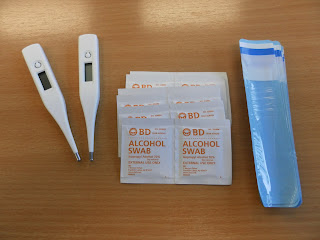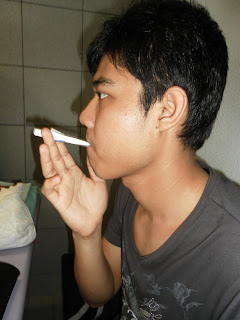
INTRODUCTION
Hello people, we are from NR0901, Subgroup 2. Our group consists of 6 people and they are Shidah, Ma Yan, Jacintha, Fareena, May Ting and Ying Xiu. We are currently Year 2 and we are doing a project on statistics. The project topic that we have chosen is is a person's oral temperature related to the axilla temperature?
We have decided to do on this topic because we find that this topic is something relevant to our nursing practices in hospital. Temperature taking is the most basic procedure that we do everytime whenever we are working in hospital wards. The common temperature route taken on patients are oral and axillary. However, these 2 route temperature readings are commonly mix up by nurses and they may or may not know there is actually differences between oral temperature and axilla temperature. Randomly choosing the route to take patient's temperature may not be effective and accurate to determine the reading. Therefore, in our research, we need to find out if there is a difference in temperature between both oral and axillary which may affect the patient's condition.
RESEARCH TOPIC
Person's oral temperature related to axilla temperature.
RESEARCH QUESTION
Is a person's oral temperature related to axilla temperature?
VARIABLES
Dependent variable: Oral
Independent variable: Axillary
Extraneous variables: Age, gender, cold/hot beverages.
TESTABLE HYPOTHESIS
Alternative hypothesis (H1): There is a significant relationship between oral and axilla temperature.
Null hypothesis (H0): There is no significant relationship between axilla and oral temperature.
CONCEPTUALIZATION
Temperature is defined as degree of heat in a living body.
4 different route of themperature taking:
- Oral: place under tongue
- Axillary: place under the armpit
- Tympanic: place the tympanic cavity
- Rectal: place in the anus
OPERATIONALIZATION
The instruments used in this research study is thermometer.
2 new thermometers are used and are all standardize by using the same brand, same model of thermometer and produced by the same manufacturer.


IMPORTANCE OF STUDY
1) Relevant skills towards nursing
2) Temperature is important because it keeps our bodies working and functioning properly.
3) Temperature tells us whether the body is normal or abnormal.
DATA COLLECTION
1) Standardized of measurement site:
- Oral temperature taking: Place under the tongue (sublingual).
- Axillary temperature taking: Place thermometer on underneath right arm.
2) We tested the both thermometers we use are reading the same temperature on warm water and these are pictures to prove that both thermometers reading are most likely to be accurate.


3) Roles in our group:
- Ying Xiu: analyzing data
- May Ting: recording data
- Fareena: taking of temperature
- Jacintha: taking of temperature
- Ma Yan: taking of temperature
- Nurshidah: photo taking of participant and taking data
4) Prior to data collection:
Before carrying out our research, we conducted a short introduction to our participants.
These are what we informed our participants about:
- The purpose of our research
5) Our data collection:
Date: 2011, January 18
Time: 1500 - 1800 hours
Venue: Library, south wing & Lecture hall LTK2
Sample size: 30 participants (17 classmates, 7 random people, and 6 of us in the subgroup)
These are some pictures we have taken from our participants who help us in data collection...








Throughout our data collection, our participants and seated comfortably. They were easily taken because most of them are our classmates. We use 1 thermometer for axillary and 1 thermometer for oral. We took twice oral temperature and axilla temperature for each individual participants. We are going to key into our data the average of 2 readings for each oral and axilla. After each measurement, we use alcohol swab to clean the thermometer. We also use a sheath for the measurement for hygiene purpose. During the collection, we realise the oral temperature reading is higher than the axillary temperature for most of the participants. We collected all the data on the day itself.
METHODOLOGY

Chia, C.Y. (2009). Statistics in health sciences (4th ed). Boston: Mcgraw-hill education.
STATISTICAL ANALYSIS
After the data collection, we analyze our findings to determine whether is oral temperature related to axilla temperature.
Our data:
Data View

Variable View

Scatter plot for subgroup - female and male

Pearson's R coefficients for female and male

Our table above shows Pearson's correlation coefficient of female - 0.909 and male - 0.939
Scatter plot for both female and male (Total)
 Pearson's R coefficients for female and male (Total)
Pearson's R coefficients for female and male (Total)
Our table above shows Pearson's correlation coefficient for total is 0.912
 Chia, C.Y. (2009). Statistics in health sciences (4th ed). Boston: Mcgraw-hill education.
Chia, C.Y. (2009). Statistics in health sciences (4th ed). Boston: Mcgraw-hill education.The association for males is R=0.939, P=0.000, N=10.
The association for females is R=0.909, P=0.000, N=20.
Since both male and females Pearson's R exceed 0.8, this indicates that there is very strong relationship between person's oral and axilla temperatures.
The association for both males and females is R= 0.912, P=0.000, N=30.
The total Pearson's R exceed 0.8, which also indicates that there is very strong relationship between person's oral and axilla temperatures.
Testing null hypothesis:
Our null hypothesis: there is no significant relationship between axilla and oral temperature.
- If p is ≤ α, we would REJECT the Null Hypothesis.
- If p is > α, we cannot reject the null hypothesis.
We have set our alpha as 0.05 = 5%
- If p is ≤ 0.05, we would REJECT the Null Hypothesis.
- If p is > 0.05, we cannot reject the null hypothesis.
Since the P value for female, male and both female & male are all 0.000 which is less than alpha 0.05, therefore we reject the null hypothesis.
And accept the alternative hypothesis which is there is a significant relationship between oral and axilla temperature measurement.
CONCLUSION
Our Research Hypothesis: There is a significant relationship between oral and axilla temperature.
Implication of findings:
Temperature measurement is essential in healthcare settings. We need to measure the readings accurately to evaluate the effectiveness of healthcare management to the patient. Inaccurate readings can affect the patient's body functioning and condition and may hinder with the nursing mangement we provide for them. We ensure effectiveness, we must be consistent in the thermometer we use throughout the nursing care.
Influence of findings:
1) Some participants wore long sleeve shirt which make cause them to produce more heat, so the readings will be affected.
2) Also, long sleeve shirt makes us hard to place the thermometer at the axillary.
3) Detecting the temperature reading was quite long, so the participants actually felt uncomfortable because they have to measure both oral and axillary route for awhile.
REFLECTIONS
Ying Xiu: I feel great completing this research with the rest of my group members. Actually we didn't really know how to start this research but we manage to pull this through together. I hope whatever we learn is applicable to our nursing. And by doing this research, it actually let me know that this module wasn't that easy as we got to collect data and analyze as it seems to be. We learn how to use the program and learn how to relate such a research topic to our nursing care.
May Ting: Statistics is something new to me. I didn’t know there is a link between statistics and nursing. I learn how to use SPSS file I learn how to key in data, analyse and interpret the finding. Hopefully whatever I learn now can be applied in the future in my nursing career.
Fareena: Such a wonderful experiences; spend together as a group and being able to complete the blog before the deadline. I've learned and gained new thing about statistic, such as collecting data as samples from our fellow classmates and friends, keying data into SPSS and using SPSS to analyze the data. I believe that I might need this module in future. We really had fun and enjoyed doing the blog.
Jacintha: When we started this blog we were clueless at first. But as time went by with much research, effort and good leadership by our subgroup leader, we could put all of it together. It was a new experience for us as we have not dealt with a lot of numbers ever since the start of our life in nursing. For me, now that I have a better understanding of the basics of statistics, I hope that I cant use the skills that I heave learnt in the future for good use.
Ma Yan: Through this project, I have learnt quite a few things, such as how to collect the data, analyze and interpret the data we collected. Overall I find that doing this blog is quite interesting and all the knowledge I have learnt from this module will help me prepare my future project well. Therefore it is really a good experience in my life.
Nurshidah: Statistics is something new to us as we had never done something like this before. At first we were all clueless as to where to start and what to do. But we worked as a team and managed to overcome all the problems. Overall, we all had fun learning together. I hope everything learnt in this module will come in handy in the future. It is really interesting as this project is different from the rest that we had done.